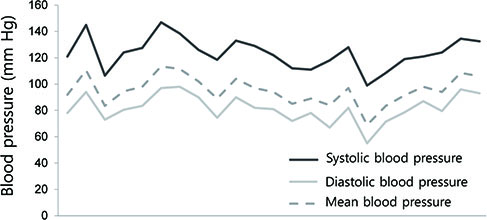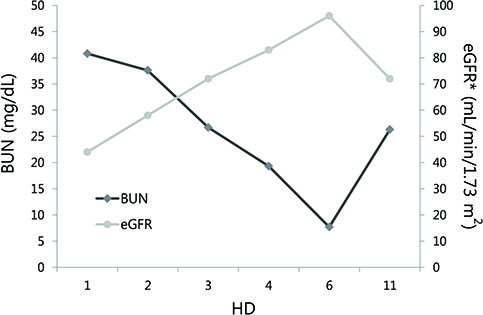Pediatr Infect Vaccine.
2017 Aug;24(2):112-116. 10.14776/piv.2017.24.2.112.
Kawasaki Disease Shock Syndrome with Acute Kidney Injury and Hypertension
- Affiliations
-
- 1Department of Pediatrics, Jeju National University Hospital, Jeju National University College of Medicine, Jeju, the Republic of Korea. hansyang78@gmail.com
- KMID: 2401453
- DOI: http://doi.org/10.14776/piv.2017.24.2.112
Abstract
- Kawasaki disease (KD) is an acute febrile mucocutaneous lymph node syndrome that commonly presents with stable hemodynamic status during the acute phase. An 8-year-old boy initially presented with severe hypotension and acute kidney injury. He was placed in the intensive care unit and was diagnosed with KD. Observed clinical features were defined as KD shock syndrome. His coronary artery was dilated during the subacute phase. Furthermore, he was given anti-hypertensive medications, owing to hypertension as an unusual complication of KD. We knew the importance of monitoring for blood pressure considering vasculitis as an aspect of the main pathogenesis of KD.
MeSH Terms
Figure
Reference
-
1. Kawasaki T. Acute febrile mucocutaneous syndrome with lymphoid involvement with specific desquamation of the fingers and toes in children. Arerugi. 1967; 16:178–222.2. Mandal S, Pande A, Mandal D, Sarkar A, Kahali D, Panja M. Various coronary artery complications of Kawasaki disease: Series of 5 cases and review of literature. J Cardiovasc Dis Res. 2012; 3:231–235.
Article3. Titze U, Janka G, Schneider EM, Prall F, Haffner D, Classen CF. Hemophagocytic lymphohistiocytosis and Kawasaki disease: combined manifestation and differential diagnosis. Pediatr Blood Cancer. 2009; 53:493–495.
Article4. Gatterre P, Oualha M, Dupic L, Iserin F, Bodemer C, Lesage F, et al. Kawasaki disease: an unexpected etiology of shock and multiple organ dysfunction syndrome. Intensive Care Med. 2012; 38:872–878.
Article5. Harada T, Ito S, Shiga K, Inaba A, Machida H, Aihara Y, et al. A report of two cases of Kawasaki disease treated with plasma exchange. Ther Apher Dial. 2008; 12:176–179.
Article6. Thabet F, Bafaqih H, Al-Mohaimeed S, Al-Hilali M, Al-Sewairi W, Chehab M. Shock: an unusual presentation of Kawasaki disease. Eur J Pediatr. 2011; 170:941–943.
Article7. Kanegaye JT, Wilder MS, Molkara D, Frazer JR, Pancheri J, Tremoulet AH, et al. Recognition of a Kawasaki disease shock syndrome. Pediatrics. 2009; 123:e783–e789.
Article8. Chen PS, Chi H, Huang FY, Peng CC, Chen MR, Chiu NC. Clinical manifestations of Kawasaki disease shock syndrome: a case-control study. J Microbiol Immunol Infect. 2015; 48:43–50.
Article9. Dominguez SR, Friedman K, Seewald R, Anderson MS, Willis L, Glode MP. Kawasaki disease in a pediatric intensive care unit: a case-control study. Pediatrics. 2008; 122:e786–e790.
Article10. Kim KY, Kim DS. Recent advances in Kawasaki disease. Yonsei Med J. 2016; 57:15–21.
Article11. Burns JC. Kawasaki disease. Adv Pediatr. 2001; 48:157–177.12. Watanabe T. Kidney and urinary tract involvement in kawasaki disease. Int J Pediatr. 2013; 2013:831834.
Article13. Mac Ardle BM, Chambers TL, Weller SD, Tribe CR. Acute renal failure in Kawasaki disease. J R Soc Med. 1983; 76:615–616.
Article14. Lurbe E, Agabiti-Rosei E, Cruickshank JK, Dominiczak A, Erdine S, Hirth A, et al. 2016 European Society of Hypertension guidelines for the management of high blood pressure in children and adolescents. J Hypertens. 2016; 34:1887–1920.
Article15. Hu P, Wang J, Fan XC, Hu B, Lu L. Hypertension triggers the rupture of coronary artery aneurysm in an 8-year-old boy with Kawasaki disease. J Clin Hypertens (Greenwich). 2014; 16:766–767.
Article16. Takahashi K, Oharaseki T, Yokouchi Y, Hiruta N, Naoe S. Kawasaki disease as a systemic vasculitis in childhood. Ann Vasc Dis. 2010; 3:173–181.
Article17. Papadodima SA, Sakelliadis EI, Goutas ND, Vlachodimitropoulos DG, Spiliopoulou CA. Atypical kawasaki disease presenting with symptoms from the genitourinary system: an autopsy report. J Trop Pediatr. 2009; 55:55–57.
Article18. Foster BJ, Bernard C, Drummond KN. Kawasaki disease complicated by renal artery stenosis. Arch Dis Child. 2000; 83:253–255.
Article19. Nagao M, Yamamoto K, Urabe T, Amakawa R, Ito A, Aosima S, et al. Percutaneous transluminal renal artery angioplasty in a 3-year-old hypertensive boy. Kokyu To Junkan. 1986; 34:1227–1230.20. Kissel M, Phoon CK, Kahn PJ. Hypertension during intravenous immune globulin infusion for Kawasaki's disease: an underreported phenomenon? Clin Pediatr (Phila). 2015; 54:491–491.
Article
- Full Text Links
- Actions
-
Cited
- CITED
-
- Close
- Share
- Similar articles
-
- Atypical Kawasaki Disease Presenting as Acute Kidney Injury in a Patient with Influenza B Virus Infection
- A Case Report of Acute Kidney Injury after Extracorporeal Shockwave Lithotripsy
- Antibody responses to HSP65 protein in Kawasaki disease
- A Case of Kawasaki Disease Associated with Acute Renal Failure and Necrotizing Myositis
- Atypical Kawasaki Disease Presented with Toxic Shock Syndrome



